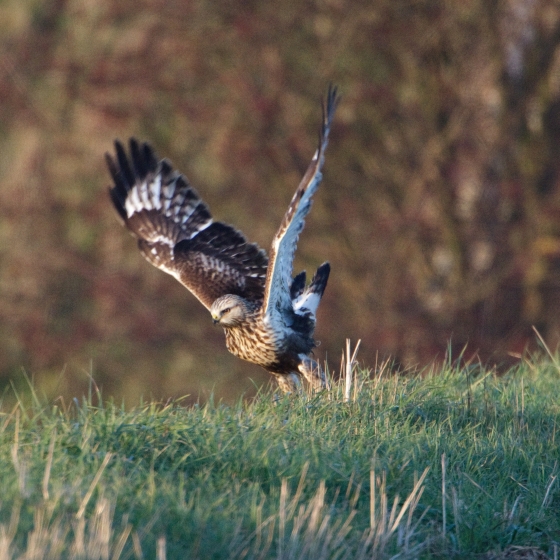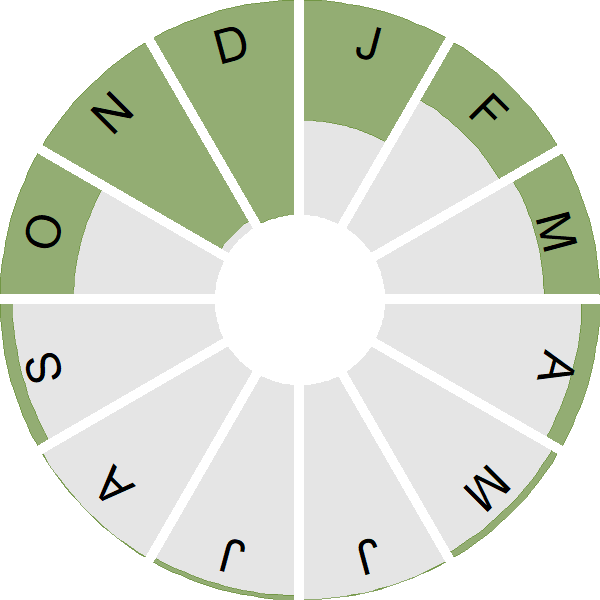Rough-legged Buzzard

Introduction
This species is exclusively a winter bird in Britain, visiting our shores from a breeding range that stretches from Norway east across Asia and North America.
Rough-legged Buzzards arrive in very small numbers in late autumn, favouring the English east coast and the northern isles of Scotland. The numbers arriving fluctuate markedly from year to year, and are probably dependent on feeding conditions in the breeding range.
Rough-legged Buzzards can be confused with pale morphs of their very common cousin the Buzzard, but a blackish-brown belly contrasting with pale head and neck, and a clear white base to the tail are reliable field features.

Key Stats
Identification
ID Videos
This section features BTO training videos headlining this species, or featuring it as a potential confusion species.
Winter Buzzards: Common and Rough-legged
Status and Trends
Conservation Status
Population Size
Population Change
Rough-legged Buzzards are primarily a winter visitor, with by far the greatest number of records along the North Sea coasts of Scotland and England [White & Kehoe 2024]. Although there have been a small number of occasions when birds were seen exhibiting breeding behaviour, There have not been any confirmed breeding records in the UK [Holling & the Rare Breeding Birds Panel 2014].
Distribution
Rough-legged Buzzards are scarce but regular autumn and winter visitors to the British east coast. During 2007–11 most records were from the eastern half of England, from Yorkshire to Kent, and on the Northern Isles.
Occupied 10-km squares in UK
2007/08–10/11
or view it on Bird Atlas Mapstore.
2008–11
or view it on Bird Atlas Mapstore.
European Distribution Map
Distribution Change
Change in occupied 10-km squares in the UK
from 1981–84 to 2007–11
or view it on Bird Atlas Mapstore.
Seasonality
Rough-legged Buzzards are scarce winter visitors, with a pulse of migrants in late autumn in some years.
Weekly pattern of occurrence
The graph shows when the species is present in the UK, with taller bars indicating a higher likelihood of encountering the species in appropriate regions and habitats.

Movement
Britain & Ireland movement
Foreign locations of birds ringed or recovered in Britain & Ireland
Dots show the foreign destinations of birds ringed in Britain & Ireland, and the origins of birds ringed overseas that were subsequently recaptured, resighted or found dead in Britain & Ireland. Dot colours indicate the time of year that the species was present at the location.
- Winter (Nov-Feb)
- Spring (Mar-Apr)
- Summer (May-Jul)
- Autumn (Aug-Oct)

European movements
EuroBirdPortal uses birdwatcher's records, such as those logged in BirdTrack to map the flows of birds as they arrive and depart Europe. See maps for this species here.
The Eurasian-African Migration Atlas shows movements of individual birds ringed or recovered in Europe. See maps for this species here.
Biology
Productivity and Nesting
Nesting timing
Egg measurements
Clutch Size
Survival and Longevity
Survival is shown as the proportion of birds surviving from one year to the next and is derived from bird ringing data. It can also be used to estimate how long birds typically live.
View number ringed each year in the Online Ringing Report.
Classification, names and codes
Classification and Codes
- Order: Accipitriformes
- Family: Accipitridae
- Scientific name: Buteo lagopus
- Authority: Pontoppidan, 1763
- BTO 2-letter code: RF
- BTO 5-letter code: ROLBU
- Euring code number: 2900
Alternate species names
- Catalan: aligot calçat
- Czech: káne rousná
- Danish: Fjeldvåge
- Dutch: Ruigpootbuizerd
- Estonian: karvasjalg-viu e. taliviu
- Finnish: piekana
- French: Buse pattue
- Gaelic: Bleidir-molach
- German: Raufußbussard
- Hungarian: gatyás ölyv
- Icelandic: Fjallvákur
- Irish: Clamhán Lópach
- Italian: Poiana calzata
- Latvian: bikšainais klijans
- Lithuanian: tubuotasis suopis
- Norwegian: Fjellvåk
- Polish: myszolów wlochaty
- Portuguese: bútio-calçado
- Slovak: myšiak severský
- Slovenian: koconoga kanja
- Spanish: Busardo calzado
- Swedish: fjällvråk
- Welsh: Boda Bacsiog
More Evidence
More evidence from Conservation Evidence.com
Partners
Citing BirdFacts
If you wish to cite particular content in this page (e.g. a specific value) it is best to use the original sources as linked in the page. For a more general citation of the whole page please use: BTO (20XX) BirdFacts Species: profiles of birds occurring in the United Kingdom. BTO, Thetford (www.bto.org/birdfacts, accessed on xx/xx/xxxx).

